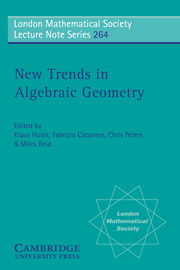Book contents
- Frontmatter
- Contents
- Foreword
- Birational Calabi–Yau n-folds have equal Betti numbers
- A Calabi–Yau threefold with non-Abelian fundamental group
- Algebraic Gromov–Witten invariants
- Kähler hyperbolicity and variations of Hodge structures
- Algorithms for computing intersection numbers on moduli spaces of curves, with an application to the class of the locus of Jacobians
- On some tensor representations of the Cremona group of the projective plane
- Hilbert schemes and simple singularities
- Bounds for Seshadri constants
- Degenerate double covers of the projective plane
- The geometry underlying mirror symmetry
- Duality of polarized K3 surfaces
- On symplectic invariants of algebraic varieties coming from crepant contractions
- The Bogomolov–Pantev resolution, an expository account
- Mordell–Weil lattices for higher genus fibration over a curve
- Symplectic Gromov–Witten invariants
- A generic Torelli theorem for the quintic
- Flops, Type III contractions and Gromov–Witten invariants on Calabi–Yau threefolds
The geometry underlying mirror symmetry
Published online by Cambridge University Press: 04 August 2010
- Frontmatter
- Contents
- Foreword
- Birational Calabi–Yau n-folds have equal Betti numbers
- A Calabi–Yau threefold with non-Abelian fundamental group
- Algebraic Gromov–Witten invariants
- Kähler hyperbolicity and variations of Hodge structures
- Algorithms for computing intersection numbers on moduli spaces of curves, with an application to the class of the locus of Jacobians
- On some tensor representations of the Cremona group of the projective plane
- Hilbert schemes and simple singularities
- Bounds for Seshadri constants
- Degenerate double covers of the projective plane
- The geometry underlying mirror symmetry
- Duality of polarized K3 surfaces
- On symplectic invariants of algebraic varieties coming from crepant contractions
- The Bogomolov–Pantev resolution, an expository account
- Mordell–Weil lattices for higher genus fibration over a curve
- Symplectic Gromov–Witten invariants
- A generic Torelli theorem for the quintic
- Flops, Type III contractions and Gromov–Witten invariants on Calabi–Yau threefolds
Summary
Abstract
The recent result of Strominger, Yau and Zaslow relating mirror symmetry to the quantum field theory notion of T-duality is reinterpreted as providing a way of characterizing geometrically which Calabi-Yau manifolds have mirror partners. The geometric description is rather surprising: one Calabi-Yau manifold should serve as a compactified, complexified moduli space for special Lagrangian tori on the other. We formulate some precise mathematical conjectures concerning how these moduli spaces are to be compactified and complexified, as well as a definition of geometric mirror pairs (in arbitrary dimension) which is independent of those conjectures. We investigate how this new geometric description ought to be related to the mathematical statements which have previously been extracted from mirror symmetry. In particular, we discuss how the moduli spaces of the ‘mirror’ Calabi-Yau manifolds should be related to one another, and how appropriate subspaces of the homology groups of those manifolds could be related. We treat the case of K3 surfaces in some detail.
Precise mathematical formulations of the phenomenon in string theory known as “mirror symmetry” have proved elusive up until now, largely due to one of the more mysterious aspects of that symmetry: as traditionally formulated, mirror symmetry predicts an equivalence between physical theories associated to certain pairs of Calabi-Yau manifolds, but does not specify any geometric relationship between those manifolds. However, such a geometric relationship has recently been discovered in a beautiful paper of Strominger, Yau and Zaslow. Briefly put, these authors find that the mirror partner X of a given Calabi-Yau threefold Y should be realized as the (compactified and complexified) moduli space for special Lagrangian tori on Y.
- Type
- Chapter
- Information
- New Trends in Algebraic Geometry , pp. 283 - 310Publisher: Cambridge University PressPrint publication year: 1999
- 4
- Cited by

